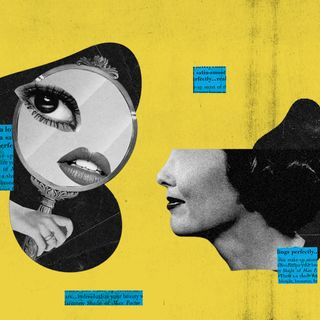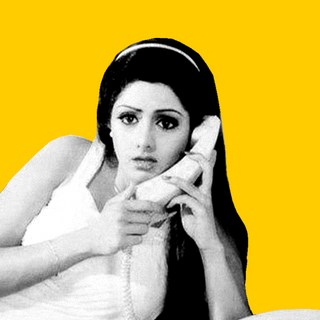
Romanticizing Y2K Led to the Resurgence of Heroin Chic
How ironic cultural nostalgia for the campy 2000s led to a cycle of problematic fashion trends recycled in new language.

In the early 2000s, US President Bill Clinton addressed a trend he found to be worrying enough to warrant a national address: “glorifying death is not good for any society.”
He was talking about “heroin chic,” the aesthetic based on strung-out models who were often high on opiates. They had under-eye bags, were most often seen with a cigarette in their hands, and famously ate very little. Kate Moss was arguably the poster girl of this when she said “nothing tastes as good as skinny feels.” It was a time of supermodel sadness, a death drive that got aestheticized not only in America but in the larger world bent on glamorizing the destruction of women as desirable.
Since then, we’ve made much headway into the conversation about body image, fashion, capitalism, and visual representations of culture, and everyone agreed that heroin chic wasn’t a good thing to glamorize.
Now, the 2000s have made a comeback, and the Y2K aesthetic is chic once more. Charms, baby tees, bright colors, micro skirts, low-rise jeans and beads are in. Slowly but surely, all of it has also led to a resurgence of heroin chic, as reflected in trending TikTok searches by today’s youth. But heroin chic has never just been about the aesthetic — it’s about privileging the hyper-skinny “heroin chic” body-type.
“It was less about fashion and more about celebrating thin bodies. In fact, the body was the fashion,” wrote Meaghan Ray, in Fashion Magazine. Today, the Y2K aesthetic pretends to reclaim heroin chic by infusing it with color and kitsch, but it still valorizes thinness to an arguably much greater degree than ever. Nostalgia for this aesthetic, combined with social media filters and algorithms mimicking these trends, are a deadly combination — one never seen before.
Related on The Swaddle:
A to Z: A Concise Dictionary of Unfeminist Fashion
And perhaps none of this should surprise us. For one, nostalgia has always worked this way. We look back to the past during times of unease but often forget the ills that characterized the era. “The correct cuttings and pastings of fashion, the consumption of products whose value has been wildly inflated in the retro market: the most banal efforts of the heroic consumer are rendered as some artistic ‘statement.’ One exudes the stylistic elements of an era without bearing any of its historical costs,” wrote Tom Vanderbilt in The Baffler.
And indeed, heroin chic was historical. It arose during a time of recession, economic austerity, and bleakness fuelled by unrealized aspirations and hopes of the 80s — leading to an overall embrace of nihilism and dishevelment that became chic. “They wanted to reclaim the body from the “dictates of fashion” and the “rationality of science,'” noted one paper on the subject. “Grunge, indie rock, riot grrrl, and later heroin chic were all anti-fashion movements; an antithesis to the
spectacle of traditional fashion.”
Ironically, the reclamation of heroin chic and the slow embrace of thinness is rooted in spectacle — it would not exist without platforms that provide a gaze to witness the transformation of the body, the appearance. If heroin chic was about rejecting fashion’s constraints and hurling into hedonistic defeatism, the 2020s era is about being looked at as confirmation of one’s existence. We’re in an age of hyper-perception as the guiding reality; and fashion, accordingly, is optimized for visibility for its own sake. We have no choice, then, but to pick from the past — and what overwhelmingly stands out is thinness as an ideal.
Related on The Swaddle:
How Instagram Aesthetics Fuel a Destructive Fast Fashion Empire
Some argue that despite all the body positivity movements and conversations, the obsession with thinness never really went away. “With the return of baby tees and low-rise jeans came the memory for many of how such clothes helped inspire in us the idea that it wasn’t that these clothes did not fit our bodies, it was our bodies that did not fit these clothes,” wrote Eva Wiseman in The Guardian. It first began as ironic reclamation. But nostalgia for the 2000s is only campy and ironic to an extent; taken too far, it risks overlooking the dangers of that era. “It was a culture defined by thinness and self-destruction, which have left dark traces in my adult life… Glamorising a time which thrived on chaos and superficiality has its own dangers. During the 2000s we were taught to aspire to wealth and fame, disregarding the impact of these values on our bodies, finances and mental health.” wrote Jessica Andrews in Elle.
Andrews locates the cultural reset in the Covid19-induced restrictions that effectively paused the great churn of the world, prompting a look back into the past. The 2000s in comparison were an era of wild abandon. “Yet, have societal values progressed since the early 2000s? What does this recent nostalgia reflect about culture today?” she asks.
The answer is complicated: capitalism, social media, and postmodern superficiality have all ensured that we spiral into self-destruction without labeling it so. “It’s far easier to say the fashion industry has a problem, accusing it of glamourising death, than to say we have a problem in our youth culture,” Rebecca Arnold, a British fashion academic, told The Guardian.
Rohitha Naraharisetty is a Senior Associate Editor at The Swaddle. She writes about the intersection of gender, caste, social movements, and pop culture. She can be found on Instagram at @rohitha_97 or on Twitter at @romimacaronii.
Related


Woe Is Me! “My Long‑Distance Relationship Is Making Me Insecure. Am I Overreacting?”
